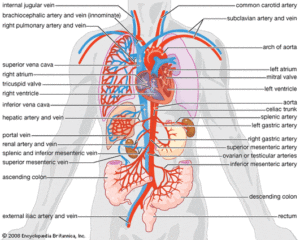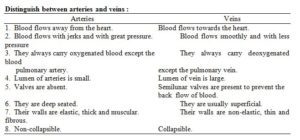Body Fluids And Circulation

The parts of the body require nourishment and oxygen and need to be removed metabolic wastes from the body. So there is a necessity of transporting various substances like digested food materials to provide energy and growth of the body such as hormones, metabolic wastes, enzymes, various gases (oxygen and carbon dioxide) etc from one part to other of the body. These functions are carried out by an extracellular fluid, which flows throughout the body. This flow is known as circulation and this system of this circulation called circulatory system.

Functions of the circulatory system :
- It transports nutrients from their sites of absorption to different tissues and organs for storage, oxidation or synthesis of tissue components.
- It also carries waste products of metabolism from different tissues to the organs meant for their excretion from the body.
- It transports respiratory gases between the respiratory organs and the tissues.
- It carries metabolic intermediates from one tissue to another for their further metabolism; for example, blood carries lactic acid from muscles to the liver for its oxidation.
- It also transports informational molecules such as hormones, from their sites of origin to the tissues.
- It uniformly distributes water, H+, chemical substances to all over the body.
Blood Vascular System :
Larger animals have a well-developed circulatory system so that transport of substances in the body can be done very effectively. In these consists of a central pumping organ called as a heart and various blood vessels (arteries, veins, and capillaries). Arteries conduct the blood from the heart to other tissues; veins bring blood from other tissues to the heart. Some of the invertebrates and all vertebrates possess this system. William Harvey was first discovered and demonstrated the circulatory system.
The blood vascular system is of two types, the open and the closed circulatory systems.
- Open circulatory system :
In many advanced invertebrates such as prawns, insects, and mollusks, the blood does not remain confined to blood vessels but it flows freely through the body cavity and channels called lacunae and sinuses in the tissues. The body cavity is known as hemocoel and the blood is hemolymph. In insects, the tissues are in direct contact with the blood. Haemolymph circulates in the whole body due to the contractile activity of the heart.
- Closed circulatory system :
In a closed circulatory system, the blood flows through proper blood vessels named arteries, veins and blood capillaries. Arteries within the tissues divide into arterioles, which then branch further to form capillaries. Capillaries then unite to form venules, which come out of the tissues and veins. Arteries have thick, elastic and muscular walls which are made up of three concentric layers viz., tunica external, tunica media and tunica interna. All these layers have got smooth or involuntary muscles. Contraction and relaxation of smooth muscles alter the diameter of arteries and thus regulate the flow of blood through them. Capillaries are extremely fine, thin blood vessels the walls of which are made of a single layer of endothelial cells. The muscles and elastic fibers are absent in them. These capillaries are highly permeable to water and small macromolecules. Various nutrients, respiratory gases, metabolites and other substances are exchanged between the blood and tissues through these capillaries.

The Heart:
The heart is the central pumping organ of the blood vascular system. It has a hollow muscular structure and is made up of cardiac muscles. It works throughout life rhythmically without getting tired. It enclosed in a double membranous sac called pericardium that is filled with pericardial fluid.
Mainly it has two chambers in a heart i.e., auricle or atrium that receives the deoxygenated blood from various parts of the body; and a ventricle that distributes the oxygenated blood to the body. The number of these chambers varies in different animals.
In fishes, the heart is only two-chambered, one auricle and one ventricle. Both these chambers contain deoxygenated blood.
In amphibians, auricle is divided into right and left auricles. The blood after oxygenation from lungs is returned back to left auricle. Right auricle receives deoxygenated blood from various parts of the body. However, in the ventricle, there is mixing up of deoxygenated and oxygenated blood.
In reptiles, the division of the ventricle also starts but it is not complete. So the heart is incompletely four-chambered. However, there are two auricles- left and right auricles. In them, the oxygenated and deoxygenated blood are kept separate. But in the ventricle, this separation is not perfect.
Crocodiles, birds, and mammals have a complete four-chambered heart. In them, the ventricle septum is complete so that there is no mixing up of oxygenated and deoxygenated blood at all.
A structure called sinus venous is present in the hearts of fishes, amphibians, and reptiles. It receives deoxygenated blood from anterior and posterior caval veins and then that blood is poured into the heart. There is no sinus venosus in mammals.
In a Human, the heart is a hollow, cone-shaped, muscular structure that lies in the thoracic cavity above the diaphragm and in between the two lungs. It is about the size of a fist measuring about 12 cm in length and 9 cm in breadth. It weighs about 300 grams. It is a four-chambered organ-two atria or auricles and two ventricles. Deoxygenated blood is received into right auricle by superior vena cava and inferior vena cava of the body.
Heart Rate and Pulse:
Generally, the human heart beats at the rate of about 70 times per minute. But, the heartbeat rate increases during exercise, fever, and emotions like anger and fear. During each heartbeat, the blood is pumped from the ventricles of the heart into the aorta to be distributed to all parts of the body. This happens during the ventricular systole and is repeated every 0.8 seconds. The blood from aorta then goes to other arteries of the parts. This causes a rhythmic contraction in the aorta and its main arteries. It can be felt as regular jerks or pulse in the regions where arteries are present superficially like wrist, neck, and temples. This is known as an arterial pulse.
The pulse rate is, therefore, same as that of heartbeat rate. This heartbeat rate differs from species to species. Hence, larger animals have lower heart rates. For example, an elephant has a normal heartbeat rate of about 25 times per minute, whereas mouse has a normal heartbeat rate of several hundred per minute.
Circulation:
In vertebrates, the heart pumps blood into a closed circulatory system. The left ventricle ejects blood into the aorta, which gives off arteries to tissues and then the blood is returned from these tissues and organs through two veins, superior and inferior vanae cavae to the right atrium. This is known as the systemic circulation. The right ventricle pumps blood into the pulmonary trunk which divides into pulmonary arteries going to the lungs; then blood is returned to the left atrium from the lungs through the pulmonary veins. This is called the pulmonary circulation.
Arterial Blood Pressure:
The pumping action of the heart maintains a pressure of blood in the arteries. This is called Arterial blood pressure. It helps to pump blood at a high velocity along the arteries in the closed circulatory system.
Disorders of Circulatory System:
- High Blood Pressure (Hypertension): It is the term for blood pressure that is higher than normal of 120/80. In the instrument 120 is Systolic / pumping pressure, 80 is Diastolic, resting pressure. If repeated check which shows 140/90 and higher shows Hypertension. It may lead to heart diseases and also affects vital organs like brain and kidney.
- Coronary Artery Disease (CAD): it is also known as Atherosclerosis, due to damage to the blood vessels of heart tissues deposition excess of Calcium, fat, cholesterol and fibrous tissues which make the lumen of arteries narrower.
- Angina: It is also known as “angina pectoris”, it is the symptom of acute chest pain due to less oxygen supply to the heart.
4. Heart Failure: It is the state when a heart is not pumping blood effectively to other organs of the body.
Course Features
- Lectures 0
- Quizzes 0
- Skill level All levels
- Language English
- Students 0
- Assessments Yes





